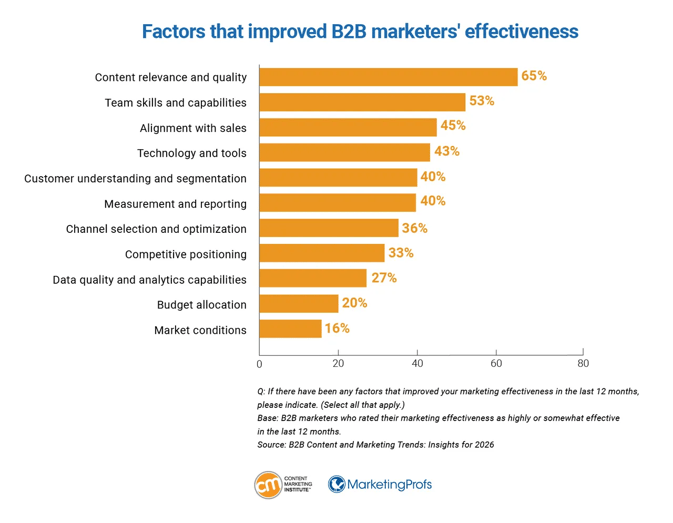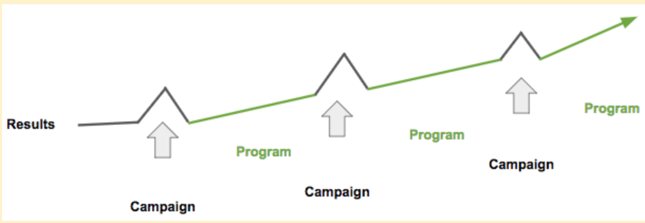Annual marketing planning is always a bet on the uncertain future. But there are some things we know about where marketing is headed that we would bet on.
We’ve been able to observe industry trends from case studies like Rula and Paylocity—that earned media coverage is the most effective way to get LLMs to surface your brand among the web’s huge library of content, clearly linking to building brand authority and credibility.
Stacker’s internal data has long led us to hypothesize that earned media and distribution provide a big boost to brand visibility, but it wasn’t until recently that we were able to show more causation than correlation, and recent research supports earned media’s relationship to LLMs’ recency bias.
Brands active for 6+ months with consistent earned distribution see:
- 40–60% increases in cumulative reach and link equity
- 2–3x improvement in referral traffic from high-authority backlinks
- Higher brand recall when surveyed against control groups
Yet somehow, 4 in 5 B2B companies aren’t prioritizing earned media in their 2026 playbooks, according to the Content Marketing Institute.

It’s not quite clear why so many brands aren’t incorporating what the research says, but it does mean that there’s still opportunity to be one of the early movers.
Here’s a look at what those 4 in 5 will be missing out on in 2026.
What’s the Problem?
Let’s take stock of what’s working and what could be better to figure out what’s happening inside the minds of marketers who aren’t betting big on earned media.
PR & viral moments still work: The old playbook of creating “PR moments” by placing a few articles in reputable outlets and then watching the brand rocket into sky-high visibility still works—but only for a blink of an eye. Much like our attention spans, the content cycle is getting ever shorter.
But they need to compound: To gain lasting authority in the minds of consumers, brands still need an always-on content strategy to stay relevant, remembered, and aligned with the algorithm’s recency bias. With the disruption of AI in search, the rhythm needs to do more than just keep up the cadence.
It needs to build upon itself.
In other words, the content you’re making should compound on itself for increased visibility and impact.

Image from The Growth Method
Always-on content might not feel feasible for small budgets or marketing teams, but these brands can perform just as well as bigger brands with the opportunity they have before them.
The opportunity is bringing human-written, excellent content to the masses in a moment filled with AI-slop—and getting that content seen.
The Solution to Compounding Visibility: Put Earned Media at the Center of the Flywheel
Compounding brand visibility requires a marketing ecosystem to build. Maybe that’s why owned and paid media are still bigger investments in the eyes of many marketers, especially since earned media is free by definition.
But making earned media the center point of your marketing ecosystem is a far more cost-effective way to build visibility because earned gives that ecosystem momentum—more eyes, higher domain rating, better AI visibility, elevated brand signals, and more.
Why don’t the other forms of media stack up the way earned media does?
Owned media: Doesn’t get seen as much, and external validation isn’t baked in.
Paid media: A pricier lever that forces eyeballs to your content at a time when ads are losing effectiveness.
Earned media: That’s a different story altogether.
Earned always includes visibility, credibility, and recency—qualities search engines prioritize. It’s inherently less promotional than other media types, which helps build trust signals that feed brand recall, click behavior, and long-term discoverability. SEO, and especially GEO, now relies as much on who’s talking about you as on what you publish.
When earned media stories hit their mark, they generate backlinks and snippet opportunities, enabling other brands and websites (or LLMs) to cite your insights.
Earned media success can make building an ecosystem around it feel more authentic:
Here’s an example of a non-cringe, non-salesy marketing flywheel in action:
- Get a story placed in a legit outlet.
- Host a LinkedIn AMA around it.
- Do a podcast interview thanks to new visibility from the earned placement.
- Clip it into 3–5 TikTok posts with top insights, each linking to your site or a down-funnel CTA.
- Post takeaways on Reddit.
Thinking about a content ecosystem from the same core belief or insight can help brands scale their marketing even with resource-strapped teams. One piece of earned media can build on itself.
Or as Ty Heath, director of market engagement for The B2B Institute @ LinkedIn put it in the Content Marketing Institute’s B2B Content Marketing Trends Research:
"The brands that win are those brave enough to challenge conventional wisdom with research-backed insights leaders can trust and act on. The most effective thought leadership supports decision-making with memorable mental models and frameworks. Each high-quality, actionable piece of thought leadership earns you compound trust and compound credibility."
“Earned Reach” Gets Content Compounding Faster with Earned Media + SEO
With earned reach, you don’t have to rely on the same journalists in your beat to keep mentioning your brand.
With earned reach distribution, your brand wears the journalist’s hat: writing stories that are actually newsworthy and distributing them to media outlets for syndication—who are hungry for content. Your content (and your brand’s visibility) scales on your terms and in your own words.
Zillow built its own infrastructure to do this, which is a major endeavor that requires lots of trust-building with many publishers. Or you could work with Stacker to do this for you.
Brands that make earned reach really work are distributing stories that are actually helpful to readers and industries, positioning themselves as leaders. The more brands do this—especially publishing net-new data to back up insights and advice—the more algorithms will reward you, and consumers will follow.
Think of the last time you saw a helpful article by a brand. You probably didn’t trust them right away (especially if it was on their own blog!). But the more you saw their in-depth content—and saw that brand mentioned on third-party sites and in LLMs—that’s the power of compounding visibility that can culminate in a no-brainer purchase when the time is right.
How Consistent Earned Reach Is Building Brand Visibility for Major Players
In 2026, early movers will continue to reap the benefits of working with Stacker to distribute their stories and get picked up by major media outlets, just like our existing clients already have:
⭐ TurboTenant: 4,300+ media pickups + 546K readers + 151K impressions in a single quarter — turned owned content into national visibility without paid amplification for increased top-of-funnel awareness and mid-funnel credibility.
⭐ Rula (formerly Path): 1,000+ pickups and repeated placements in mental health and wellness outlets — gained domain authority and higher-quality backlinks.
⭐ CheapInsurance: 500+ pickups + new backlinks across insurance and financial verticals — sustained earned coverage directly correlated with improved SEO visibility.
⭐ Paylocity: Continuous earned coverage that reinforced HR and business authority over time — helped establish the brand as a trusted voice in its category.
Now, with Stacker’s reimagined client platform, Portal 3.0, brands can see what stories are trending, get ideas for new stories backed by historical Stacker data, and understand how their earned media is reaching outlets far beyond their website.
All in all, the brands that are seeing the biggest returns aren’t the ones chasing viral moments. They’re the ones showing up consistently.
And you can do that too.
Read Stacker's State of Brand Comms for the latest on what top brands are doing to get ahead.
Benjamin Chipman is a Gen Z brand and content marketer at the intersection of media and storytelling. Informed by experiences across the creator economy and legacy media, Benjamin brings a unique perspective on where traditional and new media converge. Passionate about where brands meet culture and community, he brings this to all things marketing at Stacker. When he’s not locked in to work, he’s probably trying a new restaurant or planning his next trip to Spain.
Featured Image Credit: Photo Illustration by Stacker // Shutterstock, Canva